137 books about Texts and 13
start with M
137 books about Texts and 13
137 books about Texts
13 start with M start with M
13 start with M start with M
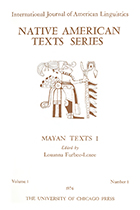
Mayan Texts
Volume II
Edited by Louanna Furbee-Losee
University of Chicago Press Journals, 1980
These volumes include oral texts in a variety of genres from 16 Mayan languages. Each of the stories in this collection is presented with analytical glosses, making explicit the structure of the language and illustrating the richness of Mayan grammar as it is used in context. These volumes will be of interest to linguists specializing in Mayan, typologists, and aficionados of oral narrative, as well as to speakers and learners of Mayan languages.
[more]
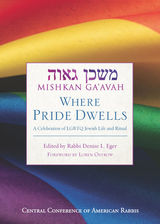
Mishkan Ga'avah
Where Pride Dwells: A Celebration of Jewish Life and Ritual
Rabbi Denise L. Eger
Central Conference of American Rabbis, 2020
This groundbreaking collection of LGBTQ prayers, poems, liturgy, and rituals is both a spiritual resource and a celebratory affirmation of Jewish diversity. Giving voice to the private and public sectors of queer Jewish experience, Mishkan Ga'avah is also a commemoration of the fiftieth anniversary of both the Stonewall Riots and the first pride march, reflecting the longtime advocacy of the Reform Movement for full LGBTQ inclusion.
[more]
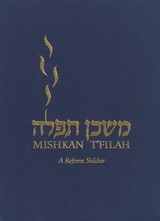
Mishkan T'filah
A Reform Siddur, transliterated (Shabbat, Weekdays, Festivals): A Reform Siddur
Rabbi Elyse D. Frishman
Central Conference of American Rabbis, 2007
Including services for Shabbat, weekdays and festivals as well as other occasions of public worship, and texts for more than a hundred songs, Mishkan T’filah reflects the full diversity of our Movement. This new Siddur includes: • Broad selection of readings, including beloved passages from our Reform liturgical tradition and great poetic writings from throughout Jewish history • Faithful, elegant translations • Contemporary, gender-inclusive English • Theological and stylistic diversity • Extensive commentaries, source notes and usage guides • More than 100 contemporary and traditional song texts • Choice of transliterated and non-transliterated editions • Innovative design in two-page spreads (additional Shabbat services in linear style also included) • Two-color printing to enhance usability
[more]
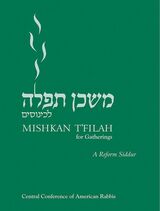
Mishkan T'filah for Gatherings
A Reform Siddur
Rabbi Sue Ann Wasserman
Central Conference of American Rabbis, 2009
A lightweight edition combining weekday and Shabbat services. Perfect for meetings, conferences, kallot, and retreats.
[more]
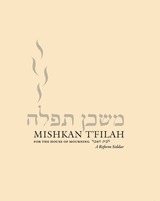
Mishkan T'filah for the House of Mourning
A Reform Siddur
Rabbi Elaine Zecher
Central Conference of American Rabbis, 2010
An innovative approach to services in the house of mourning. Includes thoughtful readings and commentary from traditional and contemporary sources. Easy-to-transport paperback format.
[more]
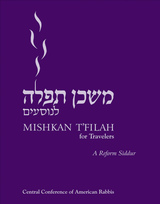
Mishkan T'filah for Travelers
A Reform Siddur
Rabbi Sue Ann Wasserman
Central Conference of American Rabbis, 2009
This compact, paperback version of Mishkan T'filah integrates weekday and Shabbat services into an easily transportable volume while still remaining faithful to the style and spirit of Mishkan T'filah. Also includes Festival liturgy.
[more]

Mishkan T'filah
Gift Edition
Elyse D. Frishman
Central Conference of American Rabbis, 2007
Including services for Shabbat, weekdays and festivals as well as other occasions of public worship, and texts for more than a hundred songs, Mishkan T’filah reflects the full diversity of our Movement. This new Siddur includes: • Broad selection of readings, including beloved passages from our Reform liturgical tradition and great poetic writings from throughout Jewish history • Faithful, elegant translations • Contemporary, gender-inclusive English • Theological and stylistic diversity • Extensive commentaries, source notes and usage guides • More than 100 contemporary and traditional song texts • Choice of transliterated and non-transliterated editions • Innovative design in two-page spreads (additional Shabbat services in linear style also included) • Two-color printing to enhance usability
[more]
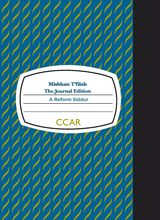
Mishkan T'filah
Journal Edition: A Reform Siddur
Rabbi Joel Abraham
Central Conference of American Rabbis, 2010
Invite your students to create their own commentary, questions, poetry, and responses to the prayers in Mishkan T'filah. For b'nai mitzvah students, confirmation class, and youth groups. Some pages will have creative, challenging prompts to stimulate thoughts, and other pages will be entirely blank, allowing users space to explore and reflect. Created by Michelle Shapiro Abraham and Joel Abraham.
[more]

Mishkan T'filah World Union Edition
Elyse D. Frishman
Central Conference of American Rabbis, 2010
Including services for Shabbat, weekdays and festivals as well as other occasions of public worship, and texts for more than a hundred songs, Mishkan T’filah reflects the full diversity of our Movement. This new Siddur includes: • Broad selection of readings, including beloved passages from our Reform liturgical tradition and great poetic writings from throughout Jewish history • Faithful, elegant translations • Contemporary, gender-inclusive English • Theological and stylistic diversity • Extensive commentaries, source notes and usage guides • More than 100 contemporary and traditional song texts • Choice of transliterated and non-transliterated editions • Innovative design in two-page spreads (additional Shabbat services in linear style also included) • Two-color printing to enhance usability
[more]
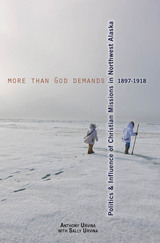
More Than God Demands
Politics and Influence of Christian Missions in Northwest Alaska, 1897-1918
Anthony Urvina with Sally Urvina
University of Alaska Press, 2016
Near the turn of the twentieth century, the territorial government of Alaska put its support behind a project led by Christian missionaries to convert Alaska Native peoples—and, along the way, bring them into “civilized” American citizenship. Establishing missions in a number of areas inhabited by Alaska Natives, the program was an explicit attempt to erase ten thousand years of Native culture and replace it with Christianity and an American frontier ethic.
Anthony Urvina, whose mother was an orphan raised at one of the missions established as part of this program, draws on details from her life in order to present the first full history of this missionary effort. Smoothly combining personal and regional history, he tells the story of his mother’s experience amid a fascinating account of Alaska Native life and of the men and women who came to Alaska to spread the word of Christ, confident in their belief and unable to see the power of the ancient traditions they aimed to supplant.
Anthony Urvina, whose mother was an orphan raised at one of the missions established as part of this program, draws on details from her life in order to present the first full history of this missionary effort. Smoothly combining personal and regional history, he tells the story of his mother’s experience amid a fascinating account of Alaska Native life and of the men and women who came to Alaska to spread the word of Christ, confident in their belief and unable to see the power of the ancient traditions they aimed to supplant.
[more]

Morning Dew and Roses
Nuance, Metaphor, and Meaning in Folksongs
Barre Toelken
University of Illinois Press, 1995
"A major academic work that is also brilliantly, clearly, humanely, and poetically written. It can be enjoyed not only by ballad and bawdry scholars but by everyone who picks it up." -- Kenneth S. Goldstein, University of Pennsylvania, former president of the American Folklore Society
"Toelken's insights . . . are unique. His study broadens and deepens scholarly appreciation of how folksong metaphors carry their own semantic weight. . . . One of the best expressions of the power of music in folksong that I have seen in recent years." -- James Porter, author of The Traditional Music of Britain and Ireland
In this lively exploration of folksongs and their meanings, Barre Toelken looks closely at riddle songs and other ambiguous folksongs, as well as the various "ballad commonplaces." Ranging through metaphors such as weaving, plowing, plucking flowers, and walking in the dew, Toelken shows how each contributes to meaning in vernacular song. He includes comparisons to German folksongs, medieval poetry, Italian folk lyrics, and a wide range of Euro-American vernacular expression.
"Toelken's insights . . . are unique. His study broadens and deepens scholarly appreciation of how folksong metaphors carry their own semantic weight. . . . One of the best expressions of the power of music in folksong that I have seen in recent years." -- James Porter, author of The Traditional Music of Britain and Ireland
In this lively exploration of folksongs and their meanings, Barre Toelken looks closely at riddle songs and other ambiguous folksongs, as well as the various "ballad commonplaces." Ranging through metaphors such as weaving, plowing, plucking flowers, and walking in the dew, Toelken shows how each contributes to meaning in vernacular song. He includes comparisons to German folksongs, medieval poetry, Italian folk lyrics, and a wide range of Euro-American vernacular expression.
[more]
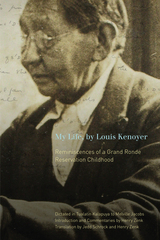
My Life, by Louis Kenoyer
Reminiscences of a Grand Ronde Reservation Childhood
Louis Kenoyer
Oregon State University Press, 2017
Louis Kenoyer, born in 1868 at Grand Ronde reservation, Oregon, was the last known native speaker of Tualatin Northern Kalapuya. His autobiographical narrative was recorded in 1928 and 1936 and is archived in the Special Collections of the University of Washington Library. Kenoyer's autobiography is a rare, first-person narrative by a Native American discussing life on an Oregon reservation. To bring his compelling story to contemporary readers, Henry Zenk and Jedd Schrock have completed a translation of the original Tualatin narrative and prepared extensive annotations and commentary to supplement the text. The original Tualatin is presented alongside the English translation.
[more]
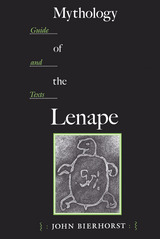
Mythology of the Lenape
Guide and Texts
John Bierhorst
University of Arizona Press, 1995
The Lenape, or Delaware, are an Eastern Algonquian people who originally lived in what is now the greater New York and Philadelphia metropolitan region and have since been dispersed across North America. While the Lenape have long attracted the attention of historians, ethnographers, and linguists, their oral literature has remained unexamined, and Lenape stories have been scattered and largely unpublished.
This catalog of Lenape mythology, featuring synopses of all known Lenape tales, was assembled by folklorist John Bierhorst from historical sources and from material collected by linguists and ethnographers—a difficult task in light of both the paucity of research done on Lenape mythology and the fragmentation of traditional Lenape culture over the past three centuries.
Bierhorst here offers an unprecedented guide to the Lenape corpus with supporting texts. Part one of the "Guide" presents a thematic summary of the folkloric tale types and motifs found throughout the texts; part two presents a synopsis of each of the 218 Lenape narratives on record; part three lists stories of uncertain origin; and part four compares types and motifs occurring in Lenape myths with those found in myths of neighboring Algonquian and Iroquoian cultures.
In the "Texts" section of the book, Bierhorst presents previously unpublished stories collected in the early twentieth century by ethnographers M. R. Harrington and Truman Michelson. Included are two versions of the Lenape trickster cycle, narratives accounting for dance origins, Lenape views of Europeans, and tales of such traditional figures as Mother Corn and the little man of the woods called Wemategunis.
By gathering every available example of Lenape mythology, Bierhorst has produced a work that will long stand as a definitive reference. Perhaps more important, it restores to the land in which the Lenape once thrived a long-missing piece of its Native literary heritage.
This catalog of Lenape mythology, featuring synopses of all known Lenape tales, was assembled by folklorist John Bierhorst from historical sources and from material collected by linguists and ethnographers—a difficult task in light of both the paucity of research done on Lenape mythology and the fragmentation of traditional Lenape culture over the past three centuries.
Bierhorst here offers an unprecedented guide to the Lenape corpus with supporting texts. Part one of the "Guide" presents a thematic summary of the folkloric tale types and motifs found throughout the texts; part two presents a synopsis of each of the 218 Lenape narratives on record; part three lists stories of uncertain origin; and part four compares types and motifs occurring in Lenape myths with those found in myths of neighboring Algonquian and Iroquoian cultures.
In the "Texts" section of the book, Bierhorst presents previously unpublished stories collected in the early twentieth century by ethnographers M. R. Harrington and Truman Michelson. Included are two versions of the Lenape trickster cycle, narratives accounting for dance origins, Lenape views of Europeans, and tales of such traditional figures as Mother Corn and the little man of the woods called Wemategunis.
By gathering every available example of Lenape mythology, Bierhorst has produced a work that will long stand as a definitive reference. Perhaps more important, it restores to the land in which the Lenape once thrived a long-missing piece of its Native literary heritage.
[more]
READERS
Browse our collection.
PUBLISHERS
See BiblioVault's publisher services.
STUDENT SERVICES
Files for college accessibility offices.
UChicago Accessibility Resources
home | accessibility | search | about | contact us
BiblioVault ® 2001 - 2024
The University of Chicago Press









